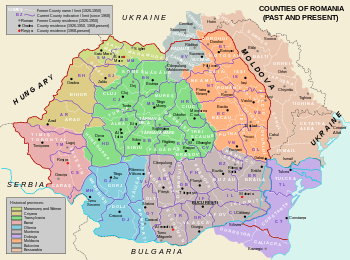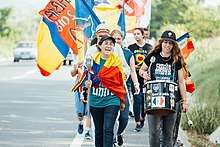Centenary March
The Centenary March (Romanian: Marșul Centenarului) or Centenary March of the Great Union (Romanian: Marșul Centenarului Marii Uniri) was a civic demonstration organized by various non-governmental organizations from Romania and Moldova, known under the collective name "Alliance for the Centenary". It started in Alba Iulia (Romania) on 1 July 2018 and ended in Chișinău (Moldova) on 1 September 2018. Its participants, both Moldovans and Romanians, targeted 300 cities and villages, passing through several points significant for the Great Union (Bessarabia, Bukovina and Transylvania).
Background

In 1859, the Romanian principalities of Moldavia and Wallachia that had been formed in the 13th century united and formed the United Principalities, which would later gain independence in 1878 and become the Kingdom of Romania in 1881. The formation of a Romanian state allowed the emergence of the concept of Greater Romania, a state that would include all the territories inhabited by ethnic Romanians. These territories consisted of Bessarabia and Bukovina, which belonged to the Principality of Moldavia until 1812 and 1775 respectively, as well as Transylvania and the neighboring regions of Banat, Crișana and Maramureș. The National Liberal Party, which made the unification of the two principalities possible, adopted the "unification at all cost" as its main goal in the early 20th century.[1] This became an important possibility after the signing of the Treaty of Bucharest in 1916, in which the Entente promised to Romania basically all of these territories with the exception of Bessarabia, part of the Russian Empire. Romania entered World War I shortly after the signing of this treaty, eventually ending up on the victory of the Entente.[2] After the collapse of Austria-Hungary, the Romanians of Bukovina declared union with Romania on 28 November 1918, later recognized by Austria in the Treaty of Saint-Germain-en-Laye[2]. The National Assembly of Romanians of Transylvania and Hungary proclaimed the union of Transylvania, Banat, Crișana and Maramureș with Romania on 1 December 1918.[3] Eventually the Treaty of Trianon of 1920 settled the new borders between Hungary and Romania which only partially fulfilled the Romanian claims. Therefore, 1 December 1918 meant not only the establishment of Greater Romania, but the achievement of the greatest Romanian national ideal. This day became the Great Union Day, being celebrated every 1 December in the country.[4]
The situation in Bessarabia was, however, different. On 15 December 1917, the Sfatul Țării ("Country Council") declared the Moldavian Democratic Republic as an autonomous republic within the Russian Democratic Federative Republic. Russia at the time was experiencing a civil war, which had strongly affected the army operating on the Eastern Front. This provoked conflicts between the Romanian and Russian army which were supposed to cooperate on this front. The Sfatul Țării repeatedly asked the Entente for help against the Bolsheviks, and therefore, in early 1918, Romanian troops began to occupy Bessarabia. The Romanian army ended the disorder that the Bolshevik troops had caused and began to be well received by the Bessarabian population. Furthermore, in January 1918, the Ukrainian People's Republic declared independence, severing any territorial connection between Russia and Bessarabia. Therefore, on February 5 (the day in which Wallachia and Moldavia united 59 years earlier), the Moldavian Democratic Republic declared its independence and, on April 9, declared union with the Kingdom of Romania. However, the newly formed Russian Soviet Federative Socialist Republic was strongly against this, and repeatedly protested at the Paris Peace Conference. The Treaty of Paris of 28 October 1920 formalized the unification of Bessarabia with Romania, but nevertheless, Japan never ratified it, so it never came into force.[5]
After the formation of the Soviet Union, it maintained its policy. Several plans were made for the recovery of the territory. During future negotiations and conferences, Romania tried to normalize its relations with the Soviet Union and even proposed a non-aggression pact, without success. The first was later accomplished in one way and another in 1934, but it did not ensure the end of the dispute. Romania had several alliances with various neighbouring countries in order to secure its borders from a possible Soviet aggression, but however, these allies began to fall. The Molotov–Ribbentrop Pact of 1939 between Nazi Germany and the Soviet Union acknowledged Soviet sovereignty in the region. Therefore, taking advantage of Romania's diplomatic situation, the Soviet Government issued an ultimatum to the Romanian one ordering the cession of Bessarabia, as well as Northern Bukovina, taken as compensation for the "suffering" experienced by the Bessarabians since 1918. In the ultimatum, it was said that both regions had an ethnic Ukrainian majority. The Romanian government ended up accepting the ultimatum and subsequently ceded Northern Transylvania to Hungary as well. Although Romania would recover Bessarabia and Bukovina during Operation Barbarossa followed by the creation of Transnistria Governorate, this invasion failed and the territories returned under Soviet control. The new land was reorganized. The north and south (Budjak) of Bessarabia (with a mostly Slavic population), as well as Northern Bukovina, were assigned to the Ukrainian Soviet Socialist Republic, while a small strip of land east of the Dniester River (modern day Transnistria) was ceded to the new Moldavian Soviet Socialist Republic.[6]
Organization of the march
The march was 1,300 km long and was initially divided into 11 stages of more or less 5 days each:[7]
- Alba Iulia - Căianu Mic (1–5 July)
- Căianu Mic - Bahnea (7–11 July)
- Bahnea - Sibiu (13–17 July)
- Sibiu - Curtea de Argeș (18–22 July)
- Curtea de Argeș - Târgoviște (24–28 July)
- Târgoviște - Cerașu (29 July–3 August)
- Cerașu - Ojdula (5–9 August)
- Ojdula - Tecuci (11–15 August)
- Tecuci - Vaslui (17–20 August)
- Vaslui - Iași (21–24 August)
- Iași - Chișinău (26 August–1 September)
In the Centenary March, generally between 20 and 30 km per day were walked on foot. During it, the participants intended to collect one million signatures to launch a referendum on the unification of Romania and Moldova, which was one of the main objectives of the march.[8][9] Participants were often accompanied by three buses sent by the city hall of Iași, each with a color of the flag of Romania (blue, yellow and red). They were used as "mobile museums" with images from the First World War and the Great Union.[10]
Crossing of the border with Moldova
On August 27, 2018, although the participants did not encounter any problems with the Romanian Border Police, the authorities of the Republic of Moldova did not allow them to enter under the pretext of "disturbance of the public order in the border area". When Romania asked for an explanation for this ban two days later, the Moldovan authorities allowed the participants to enter with the exception of George Simion, an activist for the unification, who was returned to Romania without a clear explanation. At first he was banned from entering Moldova for 24 hours, but after he tried to enter again, he was banned for 2 months.[11][12] Despite the obstacles from the Moldovan authorities,[13][14] the Centenary March was welcomed by thousands of enthusiasts, ending in a demonstration at the Great National Assembly Square in Chișinău.[15][16]
See also
References
- Livezeanu, Irina (2018). Cultural Politics in Greater Romania. Cornell University Press. p. 360. ISBN 9781501727719.
- Ciorteanu, Cezar (2015). "Formation and evolution of the borders of Greater Romania (1918-1940)". Codrul Cosminului. 21 (1): 49–62.
- Hitchins, Keith (2014). A concise history of Romania. Cambridge University Press. pp. 1–327. ISBN 9780521872386.
- Dungaciu, Dan; Manolache, Viorella, eds. (2019). 100 years since the Great Union of Romania. Cambridge Scholars Publishing. p. 445.
- Mitrasca, Marcel (2002). Moldova: A Romanian Province Under Russian Rule: Diplomatic History from the Archives of the Great Powers. Algora Publishing. p. 439.
- King, Charles (2013). The Moldovans: Romania, Russia, and the Politics of Culture. Hoover Press. p. 304. ISBN 9780817997939.
- "Marşul Centenarului începe din 1 iulie la Alba-Iulia. Cum poți străbate cele 300 de localități din România și R. Moldova în cei 1.300 km". Unimedia.md (in Romanian). 25 June 2018.
- Drăghici-Taraș, Iulia (8 August 2018). "Unirea Basarabiei cu România trece și prin județul Covasna". Covasna Media (in Romanian).
- "A început Marșul Centenarului: 1300 de km de la Alba Iulia la Chișinău". Cotidianul (in Romanian). 2 July 2018.
- "VIDEO – Caravana Unirii însoțește Marșul Centenarului". iasi1.ro (in Romanian).
- Necsutu, Madalin (31 August 2018). "Moldova to Allow Opposing Protests in Capital". Balkan Insight.
- "Unionistii care au pornit in marsul centenarului de la Alba Iulia au ajuns aproape de Chisinau, iar maine urmeaza sa manifeste in PMAN". ProTV Chișinău (in Romanian). 31 August 2018.
- "Patriotas rumanos y moldavos marchaban desde Iași por la unidad y son agredidos en Chișinău". El Correo de España (in Spanish). 16 September 2018.
- "Daniel Ioniță a îndemnat cetățenii români să respecte legislația R. Moldova". Deschide.md (in Romanian). 2 September 2018.
- "VIDEO // De la Alba Iulia, la Chișinău: Marșul Centenarului a ajuns în Piața Marii Adunări Naționale". jurnal.md (in Romanian). 1 September 2018.
- Armstrong, Mark (2 September 2018). "Moldova reunification rally". Euronews.
